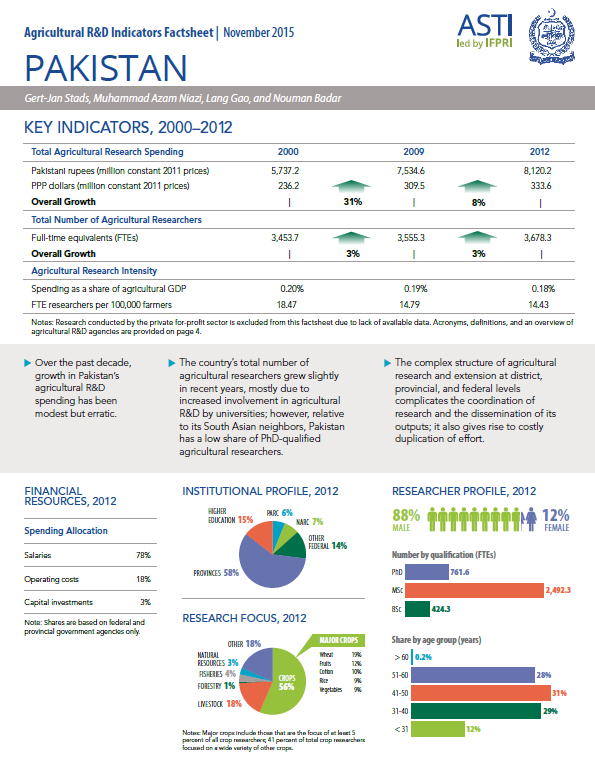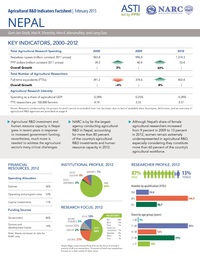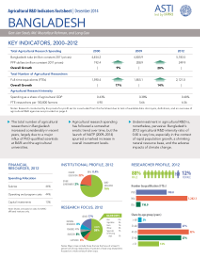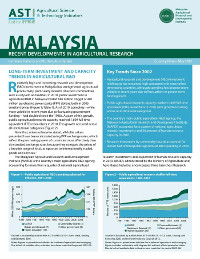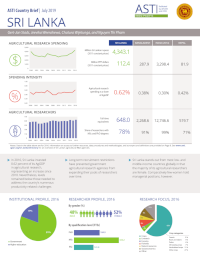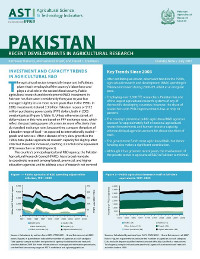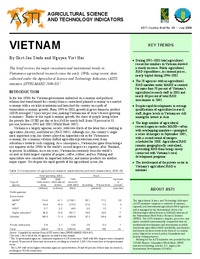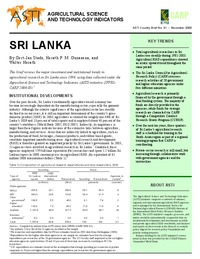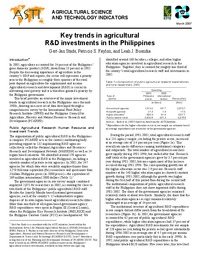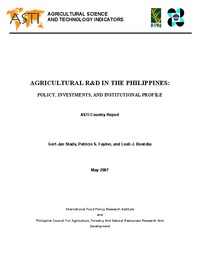Authors:
Gert-Jan Stads, Muhammad Azam Niazi, Lang Gao, and Nouman Badar
Year:
2015
Publisher
International Food Policy Research Institute and Pakistan Agricultural Research Council.
Back to:
Over the past decade, growth in Pakistan’s agricultural R&D spending has been modest but erratic.
The country’s total number of agricultural researchers grew slightly in recent years, mostly due to increased involvement in agricultural R&D by universities; however, relative to its South Asian neighbors, Pakistan has a low share of PhD-qualified agricultural researchers.
Authors:
Gert-Jan Stads, Hari K. Shrestha, Hira K. Manandhar, and Lang Gao
Year:
2015
Publisher
International Food Policy Research Institute and Nepal Agricultural Research Council
Back to:
Agricultural R&D investment and human resource capacity in Nepal grew in recent years in response to increased government funding; nevertheless, much more is needed to address the agricultural sector’s many critical challenges.
NARC is by far the largest agency conducting agricultural R&D in Nepal, accounting for more than 80 percent of the country’s agricultural R&D investments and human resource capacity in 2012.
Authors:
Gert-Jan Stads, Md. Mustafizur Rahman, and Lang Gao
Year:
2014
Publisher
International Food Policy Research Institute and Bangladesh Agricultural Research Council
Back to:
The total number of agricultural researchers in Bangladesh increased considerably in recent years, largely due to a major influx of PhD-qualified scientists at BARI and the agricultural universities.
Agricultural research spending has followed a somewhat erratic trend over time, but the launch of NATP (2009–2014) spurred a marked increase in overall investment levels.
Authors:
Flaherty, Kathleen; Abu Dardak, Rozhan
Year:
2013
Publisher
International Food Policy Research Institute (IFPRI); and Malaysian Agricultural Research and Development Institute (MARDI)
Back to:
Despite year-to-year fluctuations, agricultural research investment in Malaysia remained roughly constant between 2002 and 2010. Capacity levels did increase, however, primarily reflecting the recruitment of younger, BSc-qualified researchers. The country’s growing researcher capacity measured against a decreasing number of farmers led to a higher ratio of researchers to farmers. In comparison, research spending intensity fluctuated, largely in response to volatile AgGDP levels.
Authors:
Padmini Girihagama, Michael Rahija, and Gert-Jan Stads
Year:
2012
Publisher
Back to:
During the first decade of the new millennium, Sri Lanka’s worsening security situation forced the national government to allocate an increasing share of public resources to national security. This was at the expense of other public investments, including agricultural research. Moreover, revenues generated by a cess on plantation crops were gradually channeled away from agricultural R&D. Both factors had a notable impact on the country’s total agricultural R&D spending, which declined by roughly one-third during 2000–2009.
Authors:
Kathleen Flaherty, Muhammad Sharif, David J. Spielman
Year:
2012
Publisher
International Food Policy Research Institute (IFPRI); and Pakistan Agricultural Research Council (PARC)
Back to:
Authors:
Stads, Gert-Jan; Nguyen, Viet Hai
Year:
2006
Publisher
International Food Policy Research Institute (IFPRI); and Ministry of Agriculture and Rural Development (MARD)
Back to:
Agricultural researcher totals in Vietnam increased steadily during 1991–2003, reaching nearly 3,000 fte’s in 2003. The country’s agricultural R&D expenditures almost tripled throughout 1996–2002 as a result of an increased commitment by the national government to financing agricultural research, as well as a rise in donor support. Nonetheless, average expenditures per researcher and research intensity levels are still lower than in many of Vietnam’s Southeast Asian neighbors.
Authors:
Stads, Gert-Jan; Gunasena, Herath P. M.; Herath, Walter
Year:
2005
Publisher
International Food Policy Research Institute (IFPRI); and Sri Lanka Council for Agricultural Research Policy (CARP)
Back to:
During 1981-2003, the number of agricultural researchers in Sri Lanka increased steadily. Agricultural R&D spending also rose throughout this period, albeit more erratically. In 2003, total expenditures amounted to $60 million (in 2000 constant prices). Research agencies focusing on export plantation crops reported remarkable increases in their total spending levels over the previous two decades. Combined spending totals at the eight agencies under MALLI, however, remained relatively unchanged during the same period.
Authors:
Stads, Gert-Jan; Faylon, Patricio S.; Buendia, Leah J.
Year:
2007
Publisher
International Food Policy Research Institute (IFPRI); and Philippine Council For Agriculture, Forestry And Natural Resources Research And Development (PCARRD)
Back to:
In 2005, agriculture accounted for 14 percent of the Philippines’ gross domestic product (GDP), down from 23 percent in 1982. Despite the decreasing importance of agriculture in the country’s GDP and exports, the sector still represents a priority area to the Philippines as roughly three-quarters of the rural poor depend on agriculture for employment and income. Agricultural research and development (R&D) is crucial in alleviating rural poverty and it is therefore granted a priority by the Philippine government.
Authors:
Stads, Gert-Jan; Faylon, Patricio S.; Buendia, Leah J.
Year:
2007
Publisher
International Food Policy Research Institute (IFPRI); and Philippine Council For Agriculture, Forestry And Natural Resources Research And Development (PCARRD)
Back to:
Agricultural researcher totals in the Philippines have increased gradually over the past two decades. In fact, with close to 4,000 fte researchers in 2002, the Philippines has one of the largest agricultural research systems in Asia. Nevertheless, average scientific qualifications of Philippine agricultural research staff are relatively low: less than half of all agricultural researchers held postgraduate degrees in 2002. In terms of total agricultural research spending, the Philippines ranks behind more economically advanced Asian countries.

